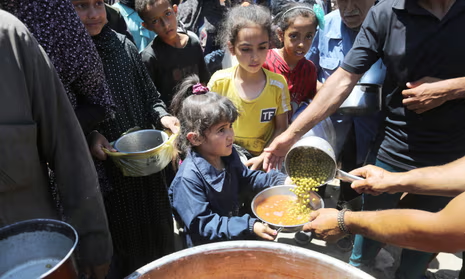Guardian:
Hunger’s role in Jewish philosophy and history makes it all the more horrifying that civilians in Gaza are eating garbage
For many months now, it has been no secret that one of America’s closest allies has been using hunger as a weapon against a civilian population. That hunger is being used by Israel is supremely ironic, given the particular role that privation from food plays both in Jewish philosophy and in the grim history of the Jewish people. It is a charge that the Jewish state has repeatedly denied in the face of overwhelming evidence to the contrary.
Beginning this past winter, Human Rights Watch and Oxfam both condemned Israel’s use of starvation as a weapon of war. Governmental organizations have also begun to echo those accusations. “In Gaza, we are no longer on the brink of a famine, we are in a state of famine,” the European Union’s foreign policy chief, Josep Borrell, said several weeks ago. The Gaza population was facing a “man-made disaster”, Borrell reported. The United Nations World Food Program concurs: a “full-blown famine” is taking place in northern Gaza, according to the head of the program. This was followed by the international criminal court considering issuing warrants against leaders of both Hamas and Israel, and, in the case of the Israelis, for the war crime of starvation of civilians.
Even Germany, which for obvious historical reasons has long been one of Israel’s staunchest allies, finally has begun to warn against using starvation to win a war. The Germans would know about such a tactic. During the second world war, 380,000 people were crowded into the Warsaw ghetto, barricaded, and left to die by the Nazis.
Much of what we know about the effects of long-term starvation comes from a manuscript smuggled out of the ghetto in 1942 and translated into English in the 1970s as Hunger Disease. The remarkable document was compiled by a heroic team of 28 Jewish doctors working under unimaginable conditions.
Hunger Disease tracks the effects of starvation with both precision and striking descriptions: in breaking starvation down into three stages, Hunger Disease catalogs stage one, when surplus fat disappears, as being “reminiscent of the time before the war when people went to Marienbad, Karlsbad, or Vichy for a reducing cure and came back looking younger and feeling better”. With time and no break in malnutrition, starvation enters stage two: “Gradually youth was drained and young people changed into withered old people.” Eventually, “like a melting wax candle”, patients slip into the final, terminal stage.
The suffering and the defiance of the inhabitants of the Warsaw ghetto have become touchstones for students of Jewish history, a story that every Jew knows well. As Holocaust museums struggle to address the Israel-Gaza war, the idea that we can somehow put what is happening in Gaza at a distant remove from the history of the Warsaw ghetto is grotesque.
To compound the irony, voluntary abstention, particularly from food, is integral to Judaism, as it is for many religions, including Christianity and Islam – both of which have roots in the Jewish tradition. Yom Kippur, the most important day of the Jewish religious calendar, has privation as its central theme: we fast from sundown to sundown, and the role of fasting in the daylong ceremony is central. Beforehand, many congregations have solemn discussions on how to survive for a single day without eating or drinking.
There are other major and minor fasting days in the Jewish tradition. Like the Day of Atonement, these limited fasts are somber occasions that mark historical events and communal mourning, and provide time for deep reflection. A fast is seen as a holy gift freely given, a sacrifice to a God that rejected sacrifices (see Abraham and Isaac). In Judaism, fasting is associated with the days marking the apostasy of the Israelites who turned away from Judaism to worship the golden calf; with the destruction of the First Temple in 586 BCE, and then the Second Temple in 70 CE.
Given this historical and religious context, it is remarkable that of all nations, the Jewish state is using mass starvation as a method of warfare.
This year, Palestinians in Gaza broke their fasts during Ramadan with scraps of garbage and tufts of grass. How can we reconcile purposefully imposed mass starvation alongside fasting’s place in Judaism as a sign of devotion, reflection and ultimately empowerment? It can only be seen as a perversion of traditional Jewish values.
Hunger is the flip side of a holy fast. It is an unholy force that does not discriminate, that does not distinguish between Hamas fighters and toddlers. Its use as a weapon of war has historically been arrogated to autocratic regimes, and it is intrinsically un-Jewish.
John Oakes is the author of The Fast: The History, Science, Philosophy and Promise of Doing Without. He is publisher of the Evergreen Review

No comments:
Post a Comment